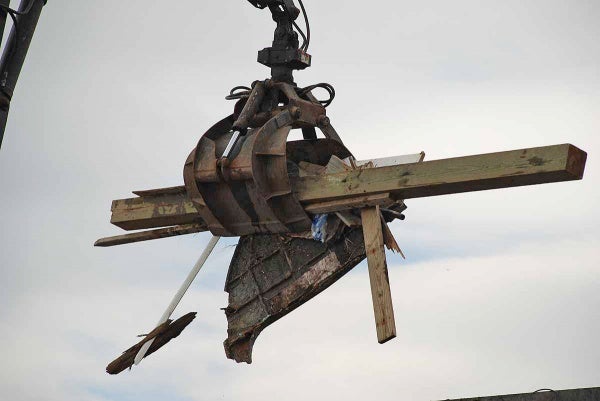Superstorm Sandy’s underwater mess in Barnegat Bay being cleaned up
Four and a half months after Superstorm Sandy barreled across the Jersey Shore, a question lingers for millions of people who love to go boating, swimming, surfing, crabbing and fishing here: Will the waters be safe in time for the summer season? The contractor cleaning up Barnegat Bay in Ocean County said he’s confident this area will be ready.
“Our goal is to be out of here by the first of June,” said Buddy Young, operations director of Alabama-based CrowderGulf. “The state wants this all cleaned up so the tourists can come back and the people can get back in their boats and feel safe using this bay.”
The hidden debris, in a bay that’s only a few feet deep in many areas, can slice open boats, damage propellers, and injure swimmers. “This is a huge boating community and everybody is on the water all summer long,” said Mantoloking Police Chief Mark Wright. “The biggest concern is people getting hurt. If you’re on a personal watercraft, and you’re out here running around the bay, it’s very easy to get hurt on some of the debris that’s in the bay now, and that’s why we’re trying to remove it.”
Sandy made a mess
Last October, the storm washed cars, boats and fractured homes off the barrier island and into the bay. The Borough of Mantoloking was particularly hard hit, when the ocean breached the island, temporarily forming a new inlet by the Mantoloking Bridge. Last week, while watching barge operators pluck lumber, entire trees, and even a hot water heater from the bay, Wright said a thorough cleanup is a must.
“There were 60 homes that washed away completely. I’m sure all that debris is out here somewhere,” said Wright, adding that crews also have removed sunken cars. “You think of the environmental impact. Cars have oil, they have transmission fluid, gasoline,” he said. “That’s not good for the bay itself, and we want to get it cleaned up.”
The Claw Game
Cleaning up the bay entails first locating submerged debris in brackish water, which is difficult to see through, except in very shallow spots. Side-scan sonar devices, attached underwater to boats, generate detailed pictures of the bottom of the bay.
“Side-scan sonar transmits a swath of sound to the left and right of the head, and it can have 150 to 500 feet of range out to either side,” said Jeff Snyder, a hydrographic surveyor working on the cleanup project. “By pairing side-scan sonar with a GPS receiver, all the imagery that we see of the bottom ends up being geographically referenced.”
A small buoy marks each spot where debris has been found. Then a barge operator uses a crane to pluck it out. It’s painstaking work; imagine playing the claw game on the boardwalk, grasping for a shifting target. “We try to work right behind it, or no more than a couple of days behind the sonar boat, because if the tide goes up or down it can move the debris,” said Young.
Full barges pull up to shore where a land-based crane operator moves the debris into a truck, for its final trip to a landfill. After nearly two weeks working the waters just north and south of the bridge, Young said his crews have recovered three cars and 2000 cubic yards of debris. Each battered canoe, part of a dock, and piece of siding removed from the water, represents another step closer to a safe summer.
After the debris removal is complete, dredging sand comes next, which residents hope will help reduce the repeated coastal flooding that’s been happening here since the storm. Sonar also will be used to locate debris in the ocean for removal.
New Jersey’s Department of Environmental Protection has hired three companies to clean up the waters along the state’s entire coastline and Delaware Bay to the Delaware Memorial Bridge, and plans to seek reimbursement for the cost from the Federal Emergency Management Agency. It’s a massive project, but one that looks doable to 68-year-old Buddy Young of CrowderGulf, who helped clean up the devastation left by Hurricane Katrina in New Orleans.
“I don’t think there’s nearly as much debris here as there was in Katrina,” said Young. “It’s yet to be seen, but we’re going to find out in the open water especially, there’s not a lot of debris out there, I don’t think. I’m confident that we’ll have the debris out of here by the first of June.”
_________________________________________________________________
Sandy Levine is a freelance writer and television producer who was born and raised at the Jersey Shore.
WHYY is your source for fact-based, in-depth journalism and information. As a nonprofit organization, we rely on financial support from readers like you. Please give today.











